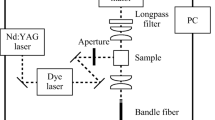Abstract
Zinc-coproporphyrin III (Zincphyrin) acts efficiently as a photodynamic therapy (PDT) agent in mice, while it shows no tumor cell-killing activity in vitro and has a high LD50 (low toxicity) in mice. It appears to have advantages over other porphyrins as a practical PDT reagent. In order to examine the action mechanism of Zincphyrin in PDT, we evaluated the photochemical characteristics of Zincphyrin by measurement of the near-infrared emission at 1268 nm, which provides direct evidence for formation of 1O2. Intense emission was observed in the presence of Zincphyrin, and was completely inhibited by NaN3, a 1O2 scavenger. Based on a quenching study, the rate constant of the reaction of 1O2 with NaN3 was determined to be 1.5–3.5 M−1 s−1, which is close to the reported value (3.8×108 M−1 s−1). The intensity of the 1O2-specific emission was proportional to both the laser power and the concentration of Zincphyrin. The fluorescence quantum yield of Zincphyrin was 0.004 in phosphate buffer (100 mM, pH 7.4), which indicates that the excited state decays via other pathway(s) faster than through the fluorescence emission pathway. The lifetime of the triplet state of Zincphyrin (210 μs) was relatively long compared to that of other porphyrins, such as hematoporphyrin (Hp) (40 μs), coproporphyrin I (50 μs), or coproporphyrin III (36 μs). These results demonstrate the photodynamic generation of 1O2 by Zincphyrin.
Similar content being viewed by others
References
Amao Y, Kamachi T, Okura I. 1998 Preparation and characterization of water-soluble viologen-linked zinc porphyrin and bisviologen-linked zinc porphyrin. Inorg Chim Acta 267, 257–263.
Ando T, Irie K, Koshimizu K, Takemura T, Nishino H, Iwashima A, Nakajima S, Sakata I. 1990 Synthesis, physicochemical properties and photocytotoxicity of five new ?-substituted chlorin e6 derivatives. Tetrahedron 46, 5921–5930.
Ando T, Irie K, Koshimizu K, Takemura T, Nishino H, Iwashima A, Takeda N, Nakajima S, Sakata I. 1993 Photocytotoxicity of water-soluble metalloporphyrin derivatives. Photochem Photobiol 57, 629–633.
Fukuzumi S, Ohkubo K, Imahori H, Shao J, Ou Z, Zheng G, Chen Y, Pandey RK, Fujitsuka M, Ito O, Kadish KM. 2001 Photochemical and electrochemical properties of zinc chlorin-C60 dyad as compared to corresponding free-base chlorin-C60, free-base porphyrin-C60, and zinc porphyrin-C60 dyads. J Am Chem Soc 123, 10676–10683.
Furuto T, Amao Y, Asai K, Okura I. 1998 Optical oxygen sensing based on T-T Absorption of zinc porphyrin. Porphyrins 7, 405–410.
Kobayashi m, Koyama S, Miyoshi N, Yokotsuka D, Watanabe M, Wolff C, Tanielian C, Totiya M, Sasaki M, Komiyama M. 1994 Photocleavage of DNA by chlorophyll and phorphyrinderivatives. Photomed Photobiol 16, 65–69.
Koide T, Ogura S, Okura I. 2002 Cellular accumulation of zinc protoporphyrin and its photodynamic effect. Porphyrins 11, 31–34.
Krammer B. 2001 Vascular effects of photodynamic therapy. Anticancer Res 21, 4271–4277.
Nagano T, Arakane K, Ryu A, Masunaga T, Shinmoto K, Mashiko S, Hirobe M. 1994 Comparison of singlet oxygen production efficiency of C60 with other photosensitizers, based on 1268 nm emission. Chem Pharm Bull 42, 2291–2294.
Parker CA, Rees WT. 1960 Correlation of fluorescence spectra and measurement of fluorescence quantum efficiency. Analyst 85, 587–600.
Pervaiz S. 2001 Reactive oxygen-dependent production of novel photochemotherapeutic agents. FASEB J 15, 612–617.
Scott J, Quirke JME, Vreman HJ, Stevenson DK, Downum KR. 1990 Metalloporphyrin phototoxicity. J Photochem Photobiol B Biol 7, 149–157.
Sibata CH, Colussi VC, Oleinick NL, Kinsella TJ. 2001 Photodynamic therapy in oncology. Expert Opin Pharmacother 2, 917–927.
Takemura T, Ohta N, Nakajima S, Sakata I. 1989 Critical importance of the triplet lifetime of photosensitizer in photodynamic therapy of tumor. Photochem Photobiol 50, 339–344.
Toriya M, Yaginuma S, Murofushi S, Ogawa K, Hayashi M, Matsumoto K. 1993 Zincphyrin, a novel coproporphyrin III with zinc from Streptomyces sp. J Antibiot 46, 196–200.
Toriya M, Yamamoto M, Saeki K, Fujii Y, Matsumoto K. 2001 Antitumor effect of photodynamic therapy with Zincphyrin, Zinc-coproporphyrin III, in mice. Biosci Biotechnol Biochem 65, 363–370.
Umezawa N, Arakane K, Ryu A, Mashiko S, Hirobe M, Nagano T. 1997 Participation of reactive oxygen species in phototoxicity induced by quinolone antibacterial agents. Arch Biochem Biophys 342, 275–281.
Author information
Authors and Affiliations
Rights and permissions
About this article
Cite this article
Yamamoto, M., Nagano, T., Okura, I. et al. Production of singlet oxygen on irradiation of a photodynamic therapy agent, zinc-coproporphyrin III, with low host toxicity. Biometals 16, 591–597 (2003). https://doi.org/10.1023/A:1023472508073
Issue Date:
DOI: https://doi.org/10.1023/A:1023472508073




